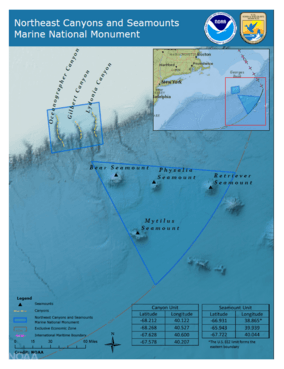Northeast Canyons and Seamounts Marine National Monument facts for kids
Quick facts for kids Northeast Canyons and Seamounts Marine National Monument |
|
|---|---|
 |
|
| Location | Atlantic Ocean |
| Area | 4,913 square miles (12,720 km2) |
| Created | September 15, 2016 |
| Governing body | U.S. Department of the Interior and U.S. Department of Commerce |
The Northeast Canyons and Seamounts Marine National Monument is a special protected area in the Atlantic Ocean. It's located off the coast of New England, near a place called Georges Bank. This monument was created by President Barack Obama on September 15, 2016. It was the very first U.S. national marine monument in the Atlantic Ocean!
This amazing area includes four underwater mountains and three very deep canyons. It's a home for many rare and endangered species, like certain whales. Some of these animals are found nowhere else on Earth.
Later, on June 5, 2020, President Donald Trump changed some rules. He allowed commercial fishing to happen in the Monument again. Some groups, like the Center for Biological Diversity, were upset by this. They said it hurt the idea of protecting marine areas.
Contents
Exploring Underwater Mountains and Canyons
The Northeast Canyons and Seamounts Marine National Monument is about 130 miles southeast of Cape Cod. It covers a huge area of 4,913 square miles (about 12,725 square kilometers).
This monument protects several amazing underwater features. These include four seamounts, which are like mountains under the sea. Their names are Bear, Mytilus, Physalia, and Retriever. It also protects three deep submarine canyons. These canyons are called Oceanographer, Lydonia, and Gilbert. They are found at the edge of the continental shelf, where the land drops off into the deep ocean.
Home to Rare Ocean Animals
This special area is a vital home for many rare and endangered species. You can find amazing creatures here!
Some of the animals that live in this monument include:
These animals need protection to survive and thrive.
Why the Monument Was Created
President Barack Obama officially made the Northeast Canyons and Seamounts Marine National Monument (NCSMNM) a protected area on September 21, 2016. He used a law called the Antiquities Act to do this. This made the monument the first and only fully protected marine sanctuary in the Atlantic Ocean.
The White House said the monument was created for a good reason. People had been asking to protect this area for about 50 years! It's a very important place because it has many different kinds of plants and animals. It's also a habitat for rare and endangered species. Plus, it's a valuable spot for scientific research and has historical importance.
Protecting the Ocean's Deep Secrets
The Northeast Canyons and Seamounts Marine National Monument was created to protect a fragile part of the ocean. This area has deep sea corals and other important species. These creatures are very sensitive to human activities like certain types of fishing or mining.
Before creating the monument, officials talked to many different groups. They met with people who care about nature, local communities, fishermen, and businesses. They gathered information about how the monument might affect people and the environment. The goal was to protect the amazing biodiversity in this area. They also wanted to help fishing businesses become more sustainable.
The monument protects about 40% of the area that was first suggested. This was decided after many discussions to be fair to everyone. Some activities are still allowed in the monument. For example, people can still go recreational fishing. Also, military activities can continue in the area.
When the monument was created, commercial fishing industries were given a 60-day period to adjust. However, some specific fisheries, like those for Atlantic Lobster and Deep-Sea Red Crab, were allowed to keep fishing in the area for seven years. The National Oceanic and Atmospheric Administration (NOAA) was asked to help these fishing businesses. They offered support like better equipment and information about fish populations.
Some commercial fishing groups were not happy with the monument's creation. They took the government to court in March 2017. They argued that President Obama didn't have the power to protect water areas under the Antiquities Act. They also said the monument was too big.
However, a judge ruled in October 2018 that the monument was legal. The judge said that the Antiquities Act allows presidents to protect both land and water. This decision was later supported by a higher court in December 2019.
Changes to Fishing Rules
On June 5, 2020, President Donald Trump signed a new order. This order removed the rules that stopped commercial fishing in the Monument. The order said that careful commercial fishing would not harm the scientific and historic features the monument protects. It also mentioned that many fish species move around a lot. It suggested that other laws already protect them enough.
Fishing groups were happy about this change. But environmental groups, like the NRDC and the Center for Biological Diversity, were not. They pointed out that government data showed that fishing businesses were doing well even with the monument's protections. They argued that allowing more fishing could harm the ocean's health.

